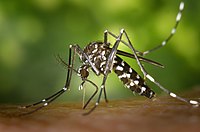
Photo from wikipedia
Aedes aegypti is the main vector of dengue globally. The variables that influence the abundance of dengue vectors are numerous and complex. This has generated a need to focus on… Click to show full abstract
Aedes aegypti is the main vector of dengue globally. The variables that influence the abundance of dengue vectors are numerous and complex. This has generated a need to focus on areas at risk of disease transmission, the spatial-temporal distribution of vectors, and the factors that modulate vector abundance. To help guide and improve vector-control efforts, this study identified the ecological, social, and other environmental risk factors that affect the abundance of adult female and immature Ae. aegypti in households in urban and rural areas of northeastern Thailand. A one-year entomological study was conducted in four villages of northeastern Thailand between January and December 2019. Socio-demographic; self-reported prior dengue infections; housing conditions; durable asset ownership; water management; characteristics of water containers; knowledge, attitudes, and practices (KAP) regarding climate change and dengue; and climate data were collected. Household crowding index (HCI), premise condition index (PCI), socio-economic status (SES), and entomological indices (HI, CI, BI, and PI) were calculated. Negative binomial generalized linear models (GLMs) were fitted to identify the risk factors associated with the abundance of adult females and immature Ae. aegypti. Urban sites had higher entomological indices and numbers of adult Ae. aegypti mosquitoes than rural sites. Overall, participants’ KAP about climate change and dengue were low in both settings. The fitted GLM showed that a higher abundance of adult female Ae. aegypti was significantly (p < 0.05) associated with many factors, such as a low education level of household respondents, crowded households, poor premise conditions, surrounding house density, bathrooms located indoors, unscreened windows, high numbers of wet containers, a lack of adult control, prior dengue infections, poor climate change adaptation, dengue, and vector-related practices. Many of the above were also significantly associated with a high abundance of immature mosquito stages. The GLM model also showed that maximum and mean temperature with four-and one-to-two weeks of lag were significant predictors (p < 0.05) of the abundance of adult and immature mosquitoes, respectively, in northeastern Thailand. The low KAP regarding climate change and dengue highlights the engagement needs for vector-borne disease prevention in this region. The identified risk factors are important for the critical first step toward developing routine Aedes surveillance and reliable early warning systems for effective dengue and other mosquito-borne disease prevention and control strategies at the household and community levels in this region and similar settings elsewhere.
Journal Title: International Journal of Environmental Research and Public Health
Year Published: 2021
Link to full text (if available)
Share on Social Media: Sign Up to like & get
recommendations!